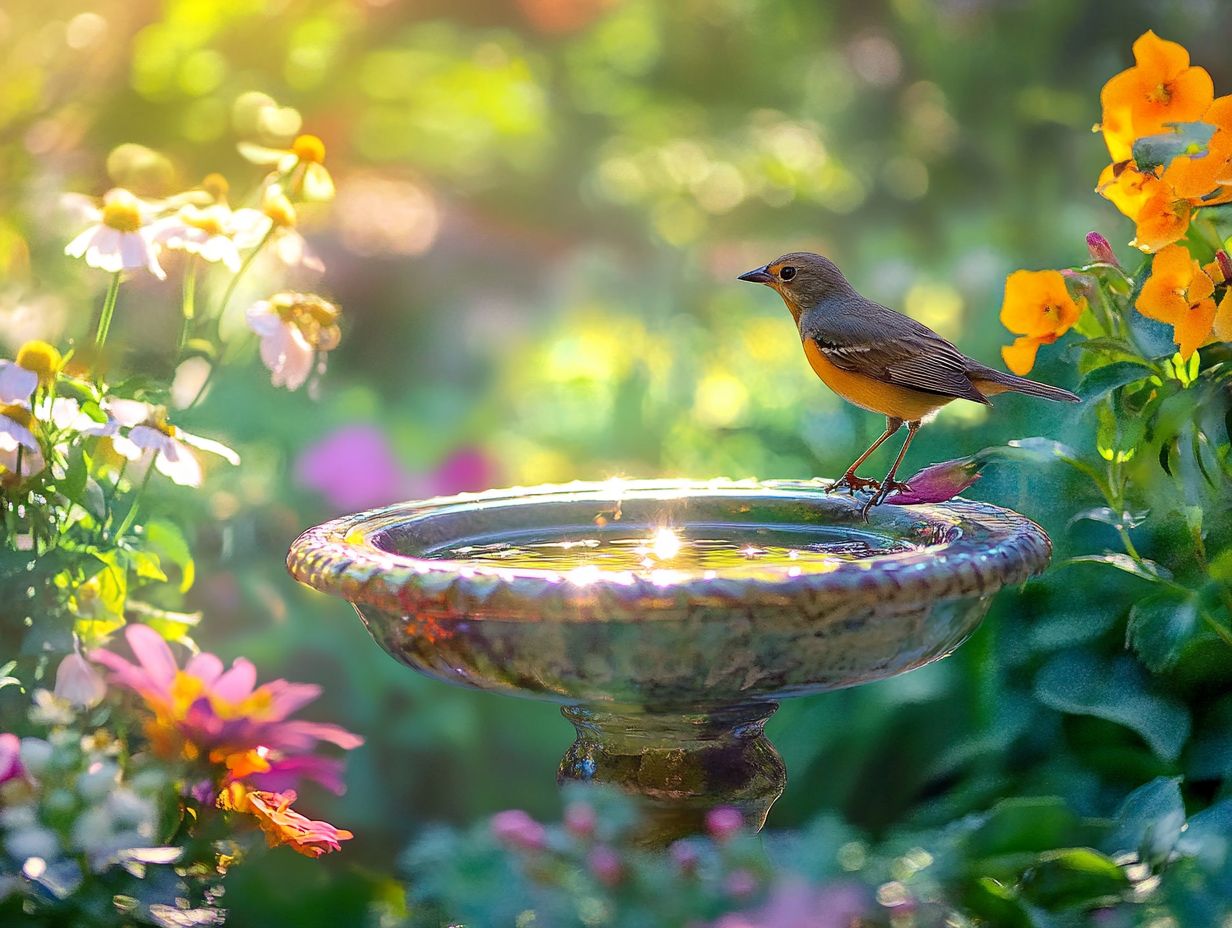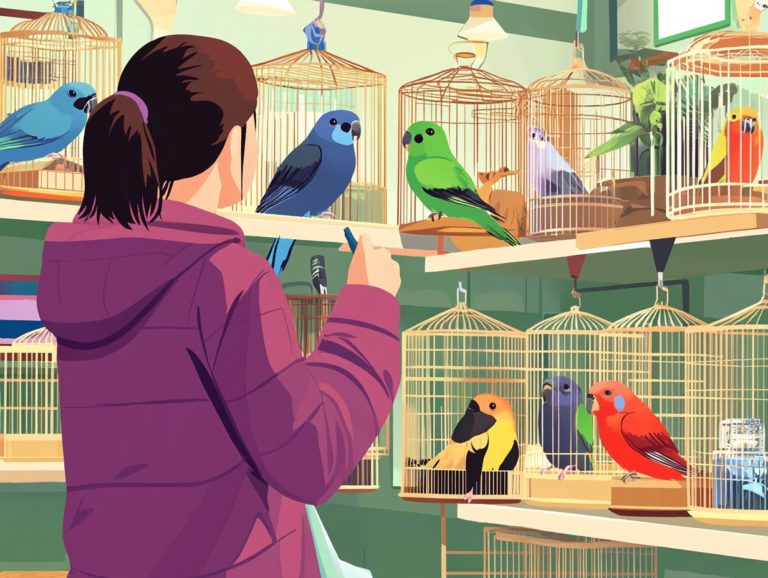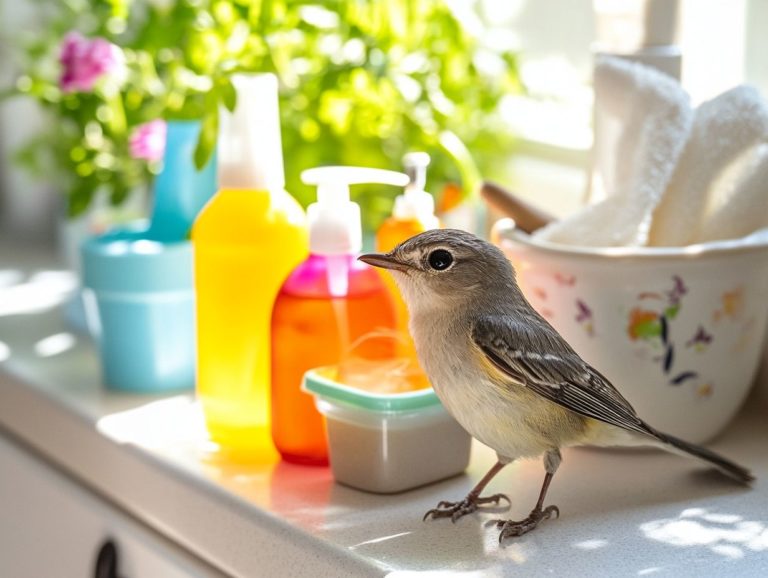What Are the Risks of Bird Bathing?
Bird bathing is a delightful and vital activity for your feathered friends, offering them a chance to cleanse their feathers and stay hydrated. However, it s not without its risks. From the potential spread of diseases to the unwelcome arrival of predators, bird bathing presents challenges that every bird lover should recognize. Let s explore the risks and learn how to create a safe, welcoming space for our feathered friends!
Contents
Key Takeaways:

- Keep your bird baths sparkling clean to keep your feathered friends safe and healthy!
- Choose a suitable location for bird baths to protect birds from predators.
- Consider alternative water sources like natural ponds and bird feeders.
What is Bird Bathing?
Bird bathing is a delightful natural behavior showcased by various bird species. It serves as both a way to clean their feathers and a vital opportunity for hydration during drier months. Basically, this ritual is key to maintaining feather health and creates an inviting atmosphere in your backyard habitat, where birds gather around baths filled with fresh, clean water.
This act plays a crucial role in their overall well-being, allowing them to remove dirt, parasites, and excess oils from their plumage. Songbirds, sparrows, and even larger species like doves revel in this refreshing activity.
By setting up a bird bath, you can attract a diverse range of avian visitors to your garden. This enhances local biodiversity while providing a captivating viewing experience. The movement and sounds of these birds not only bring joy but also contribute positively to the ecosystem, making the practice of fostering bird bathing an essential element of wildlife-friendly gardening.
Potential Risks of Bird Bathing
Bird bathing offers a multitude of benefits, yet it also carries potential risks that can negatively impact avian health, especially when water sources become dirty or contaminated.
To keep birds safe, maintain your bird bath regularly. This is essential to prevent the buildup of harmful bacteria and contaminants from debris, feces, or stagnant water. Such conditions can lead to dehydration and heatstroke in birds, making diligent care of their bathing environment paramount.
Spread of Disease
The spread of disease among birds often traces back to contaminated water sources, where disease-causing bacteria thrive. This leads to outbreaks of illnesses like Salmonellosis, Trichomoniasis, and Aspergillosis. These pathogens pose a significant threat to bird populations, especially when they gather around dirty bird baths, increasing their risk of various infections.
Take Salmonellosis, for example. It can lead to lethargy, gastrointestinal distress, and in severe cases, death particularly affecting fledglings or weakened birds.
Then there s Trichomoniasis, which often presents as mouth lesions and digestive issues. This poses a serious threat to finches and doves, frequently resulting in high mortality rates in local populations.
Aspergillosis, on the other hand, is a lung infection caused by a type of fungus that primarily impacts the respiratory system. It can cause symptoms like coughing and difficulty breathing, which can rapidly decimate flocks if left unchecked.
Scientific studies have shown a direct link between high fecal contamination in bird baths and increased disease prevalence. This underscores the critical need for maintaining proper hygiene to protect avian health and ensure their survival.
Attracting Predators
Bird baths can unwittingly become magnets for not just birds but also predators like feral housecats and other wild animals. This poses significant risks to your feathered friends. It s essential to have bird control measures in place to minimize these threats, allowing birds to bathe and drink in peace.
To create a safer sanctuary, consider strategically positioning your bird bath away from dense shrubs or any areas where predators might lurk. Choosing elevated locations can help reduce visibility and access for common threats like raccoons and hawks.
Installing barriers such as netting or wire mesh around the bathing area can further deter potential dangers. Research shows that sites with good safety practices experience a 30% increase in bird activity. This highlights the benefits of thoughtful design.
Use these strategies to turn your garden into a haven that promotes a serene and secure space for avian visitors to thrive.
Environmental Impact

The environmental impact of bird bathing goes beyond just the well-being of individual birds. It plays a significant role in the health of broader landscape wildlife and the quality of water within local ecosystems. Factors like habitat loss and the introduction of contaminants and debris into bird baths can disrupt the delicate balance of local wildlife populations and their need for fresh water sources.
Installing bird baths attracts a variety of species, providing them with essential hydration and hygiene opportunities especially during dry spells. Keeping these baths in top shape by regularly cleaning them and ensuring they re filled with fresh water is crucial. This keeps harmful algae at bay and ensures your birds have a safe haven!
Creating native plant gardens nearby can improve habitat quality. They offer shelter and food sources for both birds and beneficial insects. By embracing mindful practices, you can cultivate a thriving ecosystem that supports avian life while minimizing unforeseen negative impacts.
Safe Bird Bathing Practices
Implementing safe bird bathing practices is crucial for promoting the well-being and safety of our feathered friends. This ensures that their water sources are clean and easily accessible. Regular maintenance of bird baths, using wildlife-friendly cleaning agents, and establishing proper cleaning routines are essential.
Doing so significantly reduces harmful bacteria and contaminants that often develop in stagnant water. This creates a healthier environment for the birds to enjoy.
Proper Cleaning and Maintenance
Proper cleaning and maintenance of your bird baths are essential for providing fresh water free from harmful contaminants, debris, or chemical cleaning agents that could jeopardize bird health. Regularly replacing dirty water and employing safe cleaning methods can significantly reduce the risks associated with bird baths.
To create a pristine sanctuary for your feathered visitors, establish a routine that involves:
- Emptying the bath
- Scrubbing the bath
- Refilling the bath at least once a week especially during warmer months when algae and bacteria can thrive, ensuring no chemical exposure from harmful cleaning agents.
Opt for eco-friendly cleaners like vinegar or baking soda. These not only effectively remove grime but are also safe for the birds.
Positioning your bird bath in a shaded area further helps minimize algae growth and keep the water cool. Regularly observing the bath for debris such as leaves or dirt allows you to intervene promptly. This ensures a safe drinking space that attracts a diverse array of birds without compromising their health.
Start implementing these tips today to create a bird-friendly environment!
Choosing a Suitable Location
Choosing the right location for your bird bath is crucial in creating a safe haven for your feathered friends. It can greatly influence their behavior and eagerness to visit.
By strategically placing your bird bath away from potential predators and near natural water sources, you ll encourage regular visits and promote their health.
Consider visibility and accessibility. Position the bird bath so that birds can observe their surroundings, giving them confidence to feel secure from threats like cats or hawks. A spot close to shrubs or trees provides essential cover while still offering a welcoming space for bathing. Plus, placing the bath near feeding stations can enhance their experience, allowing for a seamless transition from munching to splashing.
A sunny location near a pond or stream can entice a variety of species, encouraging delightful and engaging behaviors. You re about to create an irresistible oasis for birds!
Protecting Birds from Predators
Protecting birds from predators is a top priority for you as a backyard birder, especially when creating a safe haven for them to bathe and drink. Implementing effective bird control methods, like placing bird baths away from potential hiding spots for predators such as feral housecats, is essential for safeguarding these delicate creatures.
Crafting a diverse landscape filled with dense shrubs and native plants plants that naturally occur in your area without human intervention can provide crucial cover for birds, allowing them to evade threats more effectively. It s also wise to monitor local predator populations to know when to be most vigilant.
Using deterrents, like specific visual barriers items that block the view and deter predators or reflective materials, can enhance the safety of these spaces. Research indicates that nearly 70% of bird species using open water sources like bird baths may face increased predation risk if proper precautions aren’t taken.
By combining thoughtful landscaping with strategic bath placement and deterrents, you can cultivate a safer and more inviting environment for your feathered friends. Act now to protect your birds from lurking threats!
Alternatives to Traditional Bird Bathing

Exploring alternatives to traditional bird bathing can enhance your backyard habitat, offering birds easier access to clean water while minimizing the risks often associated with conventional bird baths.
Consider crafting a natural water source, like a small pond or stream, or complementing your bird feeders with water trays. These options provide safe and wildlife-friendly hydration, creating a more inviting environment for your feathered friends.
Creating a Natural Water Source
Creating a natural water source in your backyard is a brilliant way to provide birds with clean water while enhancing the overall wildlife-friendly atmosphere. Consider options like small ponds, gentle streams, or even a shallow bird bath filled with fresh water. These features can attract a diverse array of bird species, promoting their health and well-being.
When designing these water features, thoughtful planning is essential. Consider factors like location and size to ensure they blend harmoniously into your landscape. Regular maintenance is key cleaning the area routinely will prevent algae buildup and keep the water fresh.
Surrounding the water source with pebbles or stones not only adds a natural touch but also provides birds with perches while they drink. Incorporating native plants nearby can further enhance the environment, offering shelter and additional food sources, transforming your water feature into a vibrant hub for local wildlife.
By ensuring the water source remains easily accessible and safe, you ll encourage more feathered friends to visit, creating a lively and picturesque scene in your backyard.
Start transforming your backyard today into a bird-friendly paradise!
Using Bird Feeders
Integrating bird feeders into your backyard habitat can significantly enhance the experience of bird bathing by providing essential nourishment and attracting a diverse array of bird populations. By ensuring access to clean water and strategically placing your feeders, you can create a holistic environment that fosters bird health and behavior.
These feeders come in a variety of designs, from tube feeders that dispense seeds to suet feeders offering high-energy treats. Each is tailored to cater to different species. Incorporating a mix of seeds, such as black oil sunflower and nyjer (a type of seed loved by finches), will entice many birds while encouraging them to take refreshing dips in nearby baths.
To create a vibrant bird community that brings joy to your backyard, consider placing your feeders and baths within a short distance of each other. This will enhance visibility for the birds while reducing their risks of predation. Periodically cleaning both feeders and baths is crucial; this prevents mold and disease and ensures that your yard remains a popular spot, as healthy birds are more likely to frequent it.
Frequently Asked Questions
What Are the Risks of Bird Bathing?
The risks of bird bathing include:
- The potential spread of diseases and parasites.
- Attracting unwanted predators.
- The potential for drowning or injuries to birds.
Can bird baths spread diseases?

Yes, bird baths can spread diseases such as avian pox, salmonellosis, and West Nile virus. These diseases can be transmitted through contaminated water or contact with infected birds.
How can I prevent the spread of diseases while bird bathing?
To prevent the spread of diseases, regularly clean and disinfect your bird bath. Avoid overcrowding of birds. Provide fresh, clean water daily and avoid placing the bird bath near feeders or areas with bird droppings.
What predators may be attracted to a bird bath?
Predators such as cats, raccoons, and hawks may be attracted to bird baths, viewing them as a source of easy prey. To prevent this, place the bird bath in a safe, open area with no hiding spots for predators.
Can birds drown in a bird bath?
Yes, birds can drown in bird baths, especially if the water is too deep or if they get trapped in the water and cannot escape. To prevent this, ensure the water is shallow enough for birds to stand in and place stones or branches in the water for birds to perch on.
Are there any other risks associated with bird bathing?
Other risks of bird bathing include potential injuries to birds from sharp edges or slippery surfaces of the bird bath. Choose a bird bath with smooth edges and a textured surface for birds to grip onto.
Start inviting beautiful birds into your yard today your feathered friends are waiting!






